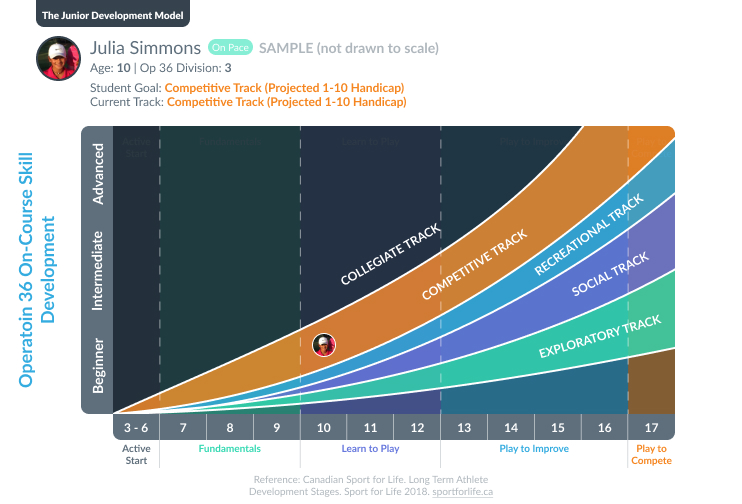
By Matt Reagan, PGA – Co-Founder and CEO, Operation 36 Golf
The game of golf mirrors life in many ways. It is a dynamic long-term journey. What we liked about the game one year, may be different the next. As a junior becomes more competent in the sport, their motivation and interests will change.
For Golf Professionals, building a junior golf developmental program comes with its challenges. One of those challenges is trying to keep parents and the juniors aligned with their goals within golf. See–there is not just one plan for juniors to travel down to become a skilled golfer.
The Operation 36 Junior Development Model
This is one of the reasons why we assembled a tailored Junior Development Model for the Operation 36 Program. The model is holistic. It takes in players’ interests, golf skill level, athlete development, personality and age into account to give coaches and parents a plan on how to make learning the game fun and enjoyable every step of the way.
When everyone knows the plan, and is on the same page from the beginning, it can make the journey much more enjoyable for the players, parents, and coaches. After we understand the age, skill level, and personality/interests of the players, we ask them what their goals in golf are currently.

Their answers to these questions help players identify and select their own Golf Development Track that match their personal interests. To compliment the selected player’s track, the technology will also show the junior, parents, and coach what the actual track the junior is on based on their golf skill level and age.
So the Junior Development Tracks accomplishes two goals
- Player Motivation – It allows golfers to select the track that matches their interests so everyone is aware of why they play and knows what will make it fun for that player.
- Golf Skill Development Projection – Based on the player’s age, it will show golfers what skill level track they are in, to let them know if they are: ahead of pace, on track, or behind pace with their goals and interests. This is only important for the junior if they have competitive aspirations. On the Golf Skill Development side, these tracks can be used to help players see where their skills will be in the future if they stick with the program. The beauty in this, is it can help a player who has a desire to play competitively see if they are “on-pace,” “behind pace,” or “on-track” with their golf skill development goals.
Juniors usually progress in these tracks in a somewhat sequential order as they progress in the sport. We have found that as juniors become more competent in the sport, their interests and goals will change. That doesn’t mean their interests will be a straight line. That is why the Tracks need to be dynamic, and we are prepared for them to go back and forth through them over time.
Here is a brief description of the tracks in order. As you read it, think to yourself, which one is my junior in currently?
- Exploratory Track – I want to try out the sport and see if it is for me (preferably with friends).
- Social Track – I like being at the course with my friends and want to get comfortable playing.
- Recreational Track – I like playing golf and find enjoyment in trying to improve my skills.
- Competitive Track – I want to take my skills and start competing against others in tournaments.
- Collegiate Track – I want to dedicate myself to playing at the highest level & love competing.
We believe our job for coaches and parents is to have a clear understanding of which track our junior is in and support their interests without installing our own personal desires for their game. THE MAIN THING WE HAVE TO REMEMBER IS THESE INTERESTS AND TRACKS ARE DYNAMIC AND WILL CHANGE OVER TIME.
It is human nature to want your junior to be the next LPGA or PGA Tour Player. What we have found is that parents just want their junior to have a sport that they can play for life together and to feel success.







